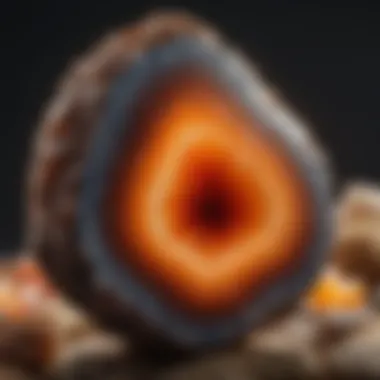Uncover the Beauty of Unpolished Rocks with Tumbler Techniques


Rock and Fossil Identification
Rock and fossil identification is a crucial aspect for rock tumbling enthusiasts. When embarking on the journey of tumbling unpolished rocks, understanding the types of rocks and fossils suitable for the tumbler is paramount. Experienced collectors know the importance of recognizing the distinct characteristics unique to each rock or fossil. Tools such as magnifying glasses and mineral hardness kits aid in accurate identification, guiding collectors towards selecting the most suitable specimens for tumbling purposes.
Collecting Tips and Techniques
Delving into the world of rock tumbling requires finesse in collecting unpolished rocks. Best practices entail thorough research into prime collecting sites known for yielding high-quality specimens ideal for tumbling. Aspiring collectors should exercise caution and adhere to ethical guidelines when extracting specimens, ensuring minimal impact on the environment. Techniques for safely transporting newfound treasures back home play a pivotal role in preserving the integrity of collected rocks and fossils.
Preservation and Display
Preserving the raw beauty of rocks and fossils post-tumbling entails employing effective techniques. Proper storage methods involve utilizing airtight containers to shield specimens from external elements that may compromise their quality. Creative display ideas add a touch of artistry to showcasing freshly tumbled rocks, captivating audiences with the mesmerizing transformation from unpolished to polished state. Enthusiasts can explore various display options, from elegant stands to immersive dioramas that highlight the geological wonder of each specimen.
Geological Insights
Geological insights offer a glimpse into the fascinating world of rock formations and processes. Unraveling the historical significance of rocks and fossils sheds light on their evolution over time, unveiling the intricate narratives encapsulated within each specimen. Notable discoveries in the field of geology contribute to expanding our knowledge of the Earth's rich history, inspiring collectors to delve deeper into the wonders of nature preserved within unpolished rocks destined for the tumbler.
Preamble to Rock Tumbling
Rock tumbling serves as a meticulous process of transforming unpolished rocks into gleaming gemstones through various stages of abrasion and polishing. This article sets out to unravel the intricate art of rock tumbling, offering rock and fossil collectors a detailed guide on utilizing unpolished rocks for tumblers. Aspiring enthusiasts will delve into the nuanced process, unveiling the essence of tumbling techniques to enhance the innate beauty of raw rocks. Through careful exploration, readers will gain profound insights into the world of rock tumbling.
Understanding the Basics of Rock Tumbling
Equipment Needed for Rock Tumbling
In the realm of rock tumbling, the choice of equipment stands crucial for the successful transformation of rough stones into polished marvels. The equipment required encompasses tumblers of various sorts, abrasives, and polishing compounds. The key characteristic that distinguishes rock tumbling equipment lies in its durability and efficiency. These tools play a pivotal role in ensuring that the rocks undergo the desired transformation, catering to the specific needs of each stone type. Moreover, the unique feature of adaptability in these tools allows for versatility in tumbling operations, offering rock collectors a seamless experience in achieving polished perfection.
Process of Tumbling Rocks
At the core of rock tumbling lies the meticulous process through which coarse, jagged stones evolve into smooth, glistening gems. The process entails distinct stages of abrasion with coarse, medium, and fine grits, followed by a polishing phase to achieve a lustrous finish. The key characteristic defining the tumbling process is its ability to gradually smoothen and refine the rocks, bringing out their intrinsic beauty. One notable advantage of this process is its capacity to unveil the hidden patterns and hues within each rock, creating a visual spectacle for collectors. However, meticulous attention is required throughout the tumbling journey to ensure the desired results are achieved without compromising the integrity of the stones.
Benefits of Rock Tumbling
Embarking on the journey of rock tumbling presents enthusiasts with a myriad of benefits beyond mere aesthetic appeal. One of the standout advantages is the opportunity to witness the raw transformation of unpolished rocks into exquisite gemstones, fostering a deep appreciation for the natural world. Additionally, rock tumbling serves as a therapeutic and engaging hobby, allowing individuals to hone their patience and attention to detail. Moreover, the process of tumbling rocks provides a creative outlet for personal expression, enabling collectors to create unique pieces of art from nature's raw materials. The inherent allure of rock tumbling lies in its ability to merge science, art, and nature into a harmonious blend, enriching the lives of those captivated by its charm.
Types of Tumblers
Rotary Tumblers
Among the array of tumblers available to rock enthusiasts, rotary tumblers stand out for their versatility and efficiency in the tumbling process. The key characteristic of rotary tumblers lies in their ability to provide a consistent tumbling action, ensuring uniform abrasion and polishing of rocks. This feature makes rotary tumblers a popular choice among collectors seeking to achieve smooth, evenly polished gemstones. Furthermore, the unique feature of quiet operation sets rotary tumblers apart, offering users a tranquil tumbling experience without unnecessary noise disturbances.


Vibratory Tumblers
In the realm of rock tumbling, vibratory tumblers emerge as a distinctive option for collectors looking to expedite the tumbling process. The key characteristic defining vibratory tumblers is their rapid vibrational motion, which accelerates the abrasion and polishing stages. This dynamic feature makes vibratory tumblers an efficient choice for those seeking quick results without compromising the quality of polishing. Additionally, the unique feature of compact size in vibratory tumblers enhances their portability, allowing enthusiasts to engage in rock tumbling activities with ease.
2-Step Tumblers
For collectors seeking a simplified tumbling process, 2-step tumblers offer a streamlined approach to rock polishing. The key characteristic of 2-step tumblers lies in their dual-drum design, enabling users to progress from abrasive grits to polishing compounds seamlessly. This efficient feature makes 2-step tumblers a popular choice for beginners and experienced tumblers alike, simplifying the complex tumbling process into manageable steps. Moreover, the unique feature of cost-effectiveness in 2-step tumblers appeals to budget-conscious collectors, providing an affordable entry point to the world of rock tumbling.
Selecting the Right Rocks
In the realm of rock tumbling, the selection of suitable rocks holds paramount importance. The choice of rocks directly influences the outcome of the tumbling process, impacting the final aesthetics and quality of the polished stones. Selecting the right rocks is a meticulous process that involves consideration of various factors such as hardness, color, shape, and transparency. By understanding the characteristics of rocks for tumbling, enthusiasts can elevate their tumbling experience to new heights.
Characteristics of Rocks for Tumbling
Hardness and Durability
Hardness and durability are essential criteria when choosing rocks for tumbling. Rocks with higher levels of hardness are more likely to withstand the tumbling process without disintegrating, resulting in smoother and well-polished stones. Durability ensures that the rock maintains its integrity throughout the tumbling stages, leading to a more consistent finish. By selecting rocks with optimal hardness and durability, tumblers can achieve professional-looking results effortlessly.
Smoothness and Shape
Smoothness and shape play a vital role in the tumbling process, impacting the final appearance of the polished rocks. Rocks with naturally smooth surfaces require fewer abrasive actions during tumbling, preserving their original form while enhancing their aesthetic appeal. Similarly, the shape of the rock determines how it interacts with the tumbling medium, influencing the overall finish. Tumblers often seek rocks with smooth textures and desirable shapes to streamline the tumbling process and achieve desirable outcomes.
Color and Transparency
The color and transparency of rocks contribute significantly to their visual appeal after tumbling. Vibrant colors and transparent qualities can create stunning effects in polished stones, showcasing intricate patterns and details. Tumblers are drawn to rocks with captivating colors and varying levels of transparency, as these features enhance the overall beauty of the final products. Selecting rocks based on color and transparency allows tumblers to craft unique and eye-catching creations.
Types of Rocks Suitable for Tumbling
Agate
Agate, known for its striking banded patterns and vibrant hues, is a popular choice among tumblers. Its exceptional hardness makes it ideal for tumbling, ensuring durability throughout the process. The unique feature of agate lies in its diverse color variations and inherent translucency, adding depth and character to polished stones. Tumblers often favor agate for its consistency in achieving smooth finishes and exquisite visual effects.
Jasper
Jasper, renowned for its earthy tones and captivating designs, is coveted by tumblers for its versatile nature. With moderate hardness and a range of colors, jasper offers tumblers the opportunity to create diverse polished stones with distinctive patterns. The unique feature of jasper is its organic appeal, adding a rustic charm to tumbled rocks. Tumblers appreciate jasper for its ease of tumbling and ability to produce one-of-a-kind pieces.
Quartz
Quartz, a crystalline mineral abundant in nature, is a favored choice for tumbling enthusiasts. Its excellent hardness and transparency make it a top contender for achieving brilliant shines and intricate details in polished stones. The unique feature of quartz lies in its versatility, allowing tumblers to experiment with various colors and forms to create visually stunning results. Tumblers often turn to quartz for its durability and ability to enhance the overall aesthetics of tumbled rocks.
Preparing Rocks for Tumbling


When delving into the realm of rock tumbling, one must first understand the critical significance of preparing rocks for this process. The essence of this phase lies in ensuring that the rocks selected for tumbling are adequately cleaned and inspected. By meticulously inspecting and cleaning the rocks beforehand, collectors pave the way for a successful tumbling journey.
Cleaning and Inspecting Rocks
Removing Debris and Dirt
Embarking on the journey of rock tumbling demands a crucial preliminary step - clearing the rocks of any debris or dirt. Picture this: gritty rocks tumbling within the confines of a tumbler, potentially causing abrasions and imperfections on the surfaces. By meticulously removing debris and dirt, collectors safeguard the integrity of the tumbling process, enhancing the final result of polished rocks. This step serves as the foundation for achieving a smooth and flawless finish, underscoring its paramount importance in this article.
Checking for Cracks or Flaws
Another pivotal aspect of preparing rocks lies in checking meticulously for any cracks or flaws. Just imagine the dismay of tumbling a rock only to discover unsightly cracks post-polishing. By scrutinizing each rock for imperfections beforehand, collectors ensure that only the finest specimens undergo the transformative tumbling process. This meticulous examination guarantees a superior final product, free from blemishes and defects, elevating the overall quality of the tumbled rocks.
Breaking Down Larger Rocks
Upon completing the meticulous examination and cleaning process, collectors may encounter larger rocks requiring breaking down before tumbling. This stage introduces the necessity to employ effective hammering techniques and exercise safety precautions to enhance the rock tumbling experience.
Hammering Techniques
Embracing the art of hammering techniques proves instrumental in delicately breaking down larger rocks into tumbling-friendly sizes. Visualize skilled hands wielding hammers to precision, ensuring controlled fracturing of rocks without causing irreversible damage. This nuanced approach to hammering guarantees that rocks are adequately sized for the tumbling process, contributing to the efficiency and effectiveness of the overall journey.
Safety Precautions
Amidst the excitement of preparing rocks for tumbling, it's paramount to underscore the significance of safety precautions. Prioritizing safety measures such as wearing protective gear and maintaining a secure workspace is non-negotiable in this process. By adhering to safety protocols, collectors mitigate potential risks and foster a secure environment for rock preparation. Safety precautions serve as the cornerstone of responsible rock tumbling practices, ensuring a seamless and secure experience for all involved.
Tumbling Process
Rock tumbling is an essential part of the rock preparation process in this comprehensive guide to using unpolished rocks for tumblers. By understanding the ins and outs of tumbling, enthusiasts can transform rough, uncut rocks into beautifully polished gems. This section delves into the nuanced steps and considerations involved in the tumbling process.
Steps for Tumbling Rocks
Coarse Grit Stage
The Coarse Grit Stage plays a pivotal role in the rock tumbling process, initiating the transformation from rough to smooth. It is characterized by its rough texture, ideal for wearing down initial imperfections and shaping the rocks. This stage sets the foundation for subsequent grit stages, ensuring a gradual progression towards a polished finish. While the Coarse Grit Stage may extend the tumbling duration, its effectiveness in shaping the rocks cannot be understated, making it a popular choice among rock tumblers.
Medium Grit Stage
Transitioning from the Coarse Grit Stage, the Medium Grit Stage refines the surfaces of the rocks further. With a finer texture than the Coarse Grit, this stage focuses on smoothing out any remaining rough patches and enhancing the rocks' overall appearance. Its versatility and ability to prepare the rocks for the final polishing stage make it a valuable component in achieving a flawless finish.
Fine Grit Stage


As the rocks progress through the tumbling process, they enter the Fine Grit Stage, where precision polishing takes place. This stage refines the rocks to a high sheen, bringing out their natural beauty and luster. The Fine Grit Stage is crucial for achieving a professional-quality polish, as it smoothens the surfaces and prepares them for the ultimate stage of rock tumbling.
Polishing Stage
The final phase of the tumbling process, the Polishing Stage, elevates the rocks to a gleaming finish. With the gentlest grit in the progression, this stage focuses on buffing the rocks to perfection. The Polishing Stage enhances the rocks' shine and smoothness, providing a glossy appearance that showcases their inherent beauty. While requiring meticulous attention to detail, this stage ensures the rocks attain a mirror-like polish.
Tips for Effective Tumbling
Maintaining Proper Grit Levels
One key aspect of successful rock tumbling is maintaining proper grit levels throughout the process. Consistently monitoring and adjusting the grit ensures optimal results, preventing under or over-tumbling. By adhering to the recommended grit levels for each stage, rock tumblers can achieve the desired finish and maximize the rocks' aesthetic potential.
Monitoring Tumbling Time
Monitoring the tumbling time is crucial for achieving desired results without compromising the rocks' quality. Over-tumbling can lead to excessive wear and tear, while undertumbling may result in an incomplete polish. By carefully tracking the tumbling duration for each stage, enthusiasts can strike the right balance and produce beautifully polished rocks.
Cleaning the Rocks
Properly cleaning the rocks between grit stages is essential for maintaining the integrity of the tumbling process. Removing debris and residue ensures that each stage effectively prepares the rocks for the next phase. It is imperative to invest time and effort into cleaning the rocks thoroughly, as any overlooked impurities can hinder the overall polishing result.
Finalizing the Process
Finalizing the process is a crucial step in the rock tumbling journey, encapsulating the culmination of hard work and dedication. This section serves as the pinnacle, where the outcome of the tumbling process is unveiled to the eager eyes of the enthusiast. It is a moment of anticipation and evaluation, where each tumbled rock's transformation is meticulously inspected. Understanding the nuances of this phase is paramount, as it determines the success and satisfaction derived from the entire tumbling endeavor. Delving into this section provides a comprehensive insight into the meticulous process of finalizing the rocks' journey from unpolished roughness to gleaming beauty.
Inspecting the Tumbled Rocks
Upon completion of the tumbling process, the inspection of the tumbled rocks takes center stage, signifying the penultimate phase of the entire technique. This critical examination enables the collector to discern the fruits of their labor, ensuring that the rocks have attained the desired finish and texture. The inspected rocks undergo a detailed scrutiny, emphasizing the need for precision and attention to detail. This careful assessment sets the stage for the subsequent actions, molding the overall outcome of the tumbling procedure.
Checking for Desired Finish
Checking for the desired finish is a meticulous task that demands keen observation and discerning eyes. Evaluating the rocks for the coveted smoothness, shine, and polished gleam is imperative in achieving the desired aesthetic appeal. The process involves a thorough analysis of each rock's surface, identifying any imperfections and inconsistencies that may impact the final result. This meticulous check ensures that only the finest specimens proceed to the next stage, defining the success of the rock tumbling process.
Making Adjustments if Needed
In the event that adjustments are required post-inspection, swift and decisive action is imperative. This phase allows for refinement and correction, aiming to rectify any flaws or inconsistencies detected during the inspection. Implementing necessary modifications ensures that the final output aligns with the collector's vision, guaranteeing a satisfying end product. The ability to adapt and refine underscores the meticulous nature of the rock tumbling craft, emphasizing the pursuit of excellence and perfection.
Storing and Displaying Tumbled Rocks
The significance of storing and displaying tumbled rocks extends beyond mere practicality, transcending into the realm of artistic appreciation and curation. This segment explores the importance of preserving the beauty and allure of the tumbled rocks, emphasizing the preservation of their unique qualities. Additionally, it delves into the art of showcasing these exquisite creations, highlighting methods to accentuate their charm and intrinsic value through thoughtful presentation.
Choosing Appropriate Containers
Selecting suitable containers for storing tumbled rocks is not merely a functional aspect but a crucial decision that impacts their longevity and visual appeal. The choice of containers should align with the rocks' characteristics, providing adequate protection and showcasing their individuality. This careful selection process plays a pivotal role in maintaining the rocks' polished state and safeguarding them from external damage, ensuring their enduring beauty.
Showcasing Tumbled Rocks
The art of showcasing tumbled rocks involves a delicate balance between aesthetic presentation and artistic expression. This facet delves into creative techniques for displaying tumbled rocks, encompassing options that elevate their visual impact and allure. From arranging them in thematic displays to incorporating them into decorative pieces, showcasing tumbled rocks is a celebration of nature's artistry. This section offers insights into captivating ways to exhibit these transformed gems, inviting admiration and appreciation for their newfound splendor.







